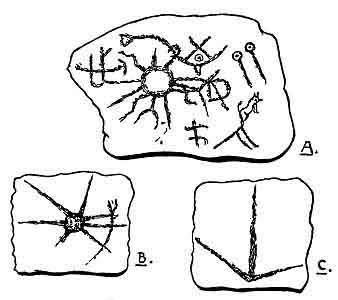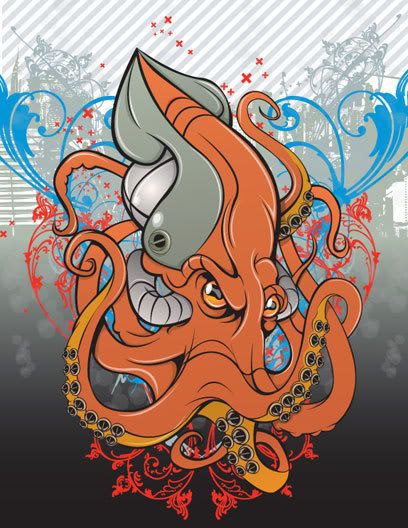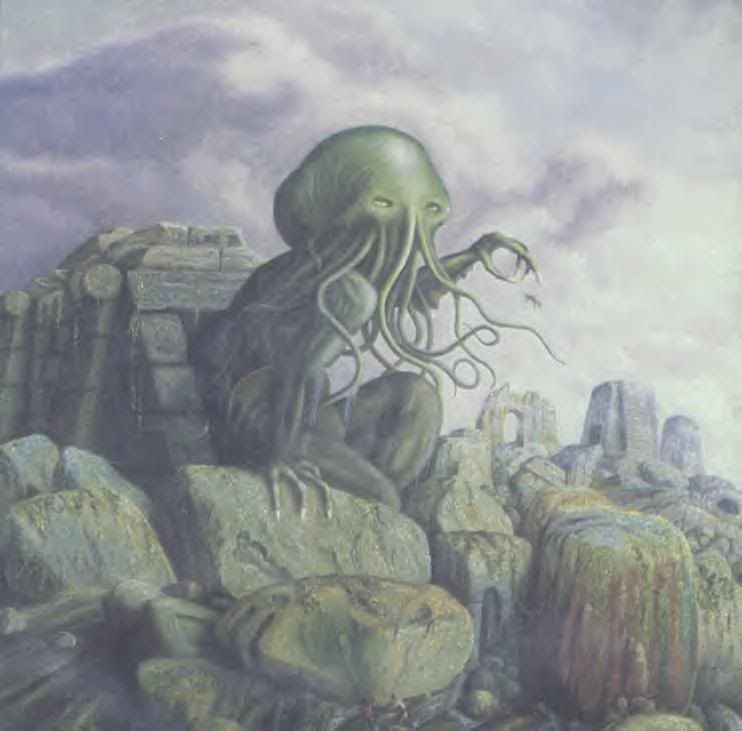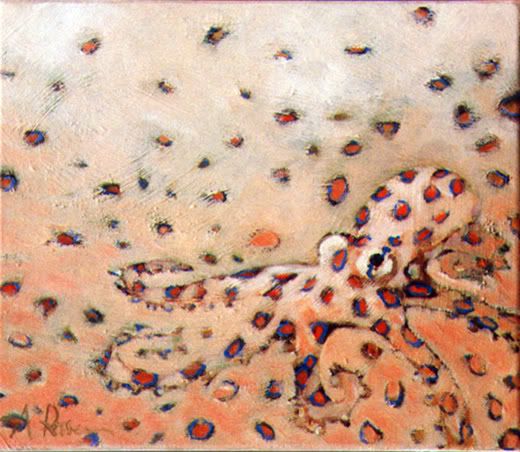Mitología del pulpo -The octopus, a sacred symbol-
Published Monday, January 31, 2005 by Spyder.The Octopus is often found on the ancient Greek pottery. It was used in Peru, Brazil, North America, Greece and Scandinavia until a few thousand years ago. Judging by the way it was used it was the symbol of a Water Demon, the Enemy of Life. Its rôle was to prevent the advent of life on earth.
Most of the ancient writings telling about the advent of life on earth symbolize it in such a manner that it represents a battle between the Sun and the Waters for supremacy over something, but does not say what that something is.
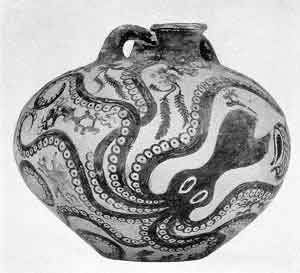
Vase of the Late Minoan I Period (about 1600-1100 B. C.) found on Gournia, Crete Courtesy of the Metropolitan Museum of Art."
For example: the Babylonians say Belmarduk, the Sun, fights Tiamet, the Waters. From a Cuneiform Tablet-"The gods are preparing for a grand contest against the monster, Tiamet." "The god Belmarduk overthrows Tiamet." The Egyptians have it that Horus, the Sun, overcomes and kills the serpent Aphopis, the Waters. The Hindus say that Krisna, the Sun, destroyed the serpent Anatha, the Waters. And the Greeks record that Apollo, the Sun, overcomes Python, the Waters. The Fifth Command of the Sacred Writings of Mu is: "And the arrows of the Sun met the arrows of the Earth in the mud of the waters and out of particles of the mud formed cosmic eggs"--life germs.
From the foregoing, combined with the legends about the Octopus, it appears that the Octopus was the symbol of the resistance of the mud against allowing the Sun's Forces to draw the Earth's Forces out into the water to form life's cosmic eggs. The Sun's Forces, however, prevailed and met the Earth's Forces and formed cosmic eggs, and life commenced according to Divine Command.
The legends as told today about the Octopus are perfect myths, but by going behind the myth and finding its origin we discover the true legend.
It was very noticeable that wherever a legend is found the phenomenon is shown to have occurred in that particular spot. This is especially so among savage and semi-savage people. As examples: the Fijians have a legend about the "Tower of Babel." According to them the "Tower of Babel" was being built on one of the Fijian Islands. The Fijians are courteous to visitors and will take anyone gladly to the spot where it stood. The Polynesians have a legend about the "Ark." They claim that it was built on one of their islands. The Maoris have a legend about "Cain and Abel." They tell you that Cain and Abel were New Zealanders and that the murder of Abel occurred in New Zealand.
The symbolic Octopus, like the Sun, is known by many names, its name being taken from the language of the people where it is found. With all people the Octopus was a Water Demon and the Enemy of Life. It had no other meaning.
SHADOWS FROM GREECE AND ASIA MINOR.--From the ancient cities of the Grecian Archipelago and Asia Minor, which have been and are being unearthed, many pieces of pottery have been found which have the Octopus either engraved, raised or painted on them, making prominent and striking decorations. In Crete, Cyprus and Troy many fine and perfect specimens have been discovered. Fortunately, the motif designs vary considerably which gives one a fair chance to read their correct meaning, as for instance, on vases B and C in the Cyprus Group. On both the tentacles and body are intact. Here the Octopus is simply a reminder of that which it symbolizes. Vase A, from the same ruined city, shows a totally different phase. Here the Octopus is depicted as having been in battle and got the worst of the encounter. This is shown by his broken and cut tentacles, his fighting weapons.
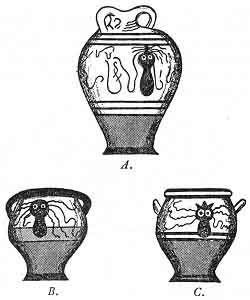 A Group of octopus vases from Cyprus
A Group of octopus vases from CyprusI think the foregoing shows sufficient proof that the Octopus was one of the early sacred symbols and that it was carried to the southeastern parts of Europe and Asia Minor by the Carians. But what people carried it to Scandinavia is an open question.
First, the Octopus has within the grasp of one of its upper tentacles a Serpent, a specialized Serpent, an exact duplication of one of the Mound Builders' Serpent Mounds. What connection is there between the Mound Builders and the people who carved this rock picture? Were they the same people? Or was this peculiar specialized Serpent used by various peoples and was this picture etched by one of them? The Octopus, having the Serpent within the grasp of one of its tentacles, intimates that the circle from which the tentacles project is the body of the Octopus; but being a circle it is a picture of the Sun. This would suggest that the circle was a Sun symbol and not the body of the Octopus.
Second, as against reading the circle as a Sun symbol we see projecting from the lower side of the circle the beak of the Octopus in the form of the ancient symbol for a cutting or dividing Force. This symbol also appears on the Mexican tablet No. 1584, Woman's Creation. Added to this in the small Fig. B, the Octopus is shown with a real body, nearly round, with the Serpent held in one of the tentacles.
Third, the foregoing shows a possibility that the circle forming the body in Fig. A may actually be symbolizing the Sun's Forces as Kin, the Celestial orb, and not Ra, the monotheistic symbol of the Deity.
One of the difficulties in attempting to read this picture is that the ends of most of the tentacles are so indistinct that their meanings are doubtful. This picture requires a great deal of study with the assistance of other pictures referring to the same subject to obtain the full meaning in detail. The fact remains that it may convey the same meaning as the Octopus on the Cyprus Vase A and many other pictures of the Greeks, Egyptians, Hindus, Babylonians, etc.
At the lower right hand corner is shown either a wolf or a dog. In the Scandinavian myths this dog or wolf plays an important part.
Labels: Mitología
Noticia -Encontrada especie de pulpos enanos entre el formol-
Published Saturday, January 29, 2005 by Spyder.Bottled Baby Octopuses Turn Out to Be Pygmies
Loren Coleman
The New York Times
September 24, 2002
Bottled Baby Octopuses Turn Out to Be Pygmies
By CHARLES Q. CHOI
In century-old jars of alcohol on museum shelves in Paris and Washington and off the coasts of Indonesia, Senegal and the Caribbean, zoologists are stumbling upon dozens of species of tiny octopuses once believed to be babies of their larger relatives.
While the researchers are not formally presenting their findings until next year after gathering more data, other top experts in the field who know of their results say these small octopuses are a big deal.
These newly recognized pygmies appear to lurk in tropical waters all over the globe, and their diversity is making scientists rethink what they know about octopuses.
"The more we look, the more we find," said Dr. Eric Hochberg, the curator of invertebrate zoology at the Santa Barbara Museum of Natural History. When octopuses this small are even spotted on expeditions, they are usually tossed in jars and forgotten, Dr. Hochberg said. Over the years, he and his colleague Dr. Mark Norman occasionally received hints that there was more than met the eye with the tiny creatures, from specimens collected during dives or from pictures of the Lilliputians apparently brooding eggs.
Upon dissecting the Marquesan and New Caledonian octopuses, instead of finding infants, Dr. Hochberg and Dr. Norman discovered full-grown adults.
Dr. Norman believes the jelly-bean-size creatures dwell in the crevices of coral reefs or small holdfasts in giant kelp "almost like the lions of miniature rain forests," devouring tiny shrimps, crabs or snails. These shadowy refuges allow the mostly drab pygmy octopuses to live without the camouflage larger species possess.
Dr. Hochberg also believes most of the pygmies probably lack poison, although one pygmy species from the Gulf of California in Mexico has a bite that causes swelling like a bee sting, he noted.
Scientists did classify a handful of pygmy species in the 1930's and 1950's, but nearly all the specimens the researchers have of these new varieties come from museum collections, so their habits remain largely a mystery.
Judging from the longer-known mini-species, the octopuses live only three or four months, compared with the one- to two-year lifetimes of their bigger relatives, the researchers said.
Dr. Hochberg, Dr. Norman and Mr. Sweeney continue to work on pygmy specimens from Senegal, Mexico, Panama, New Caledonia, the Marqueses and the Philippines, while doctorate students at the University of California at Berkeley are researching pygmy species in Indonesia and Belize. Dr. Norman says some have also been found in the cooler waters off California and
Australia, and he is holding out hope for polar species.
Labels: Noticias
Pulpos y películas -El hombre que vino a cenar-
Published Friday, January 28, 2005 by Spyder.Labels: Cine
Cocina -Empanada de pulpo-
Published Thursday, January 27, 2005 by Spyder.1 1/2 kilos de pulpo cocido.
3 Cebollas
2 dientes de ajo
2 pimientos verdes
1 pimiento rojo
1 cucharada de pimentón dulce
1/2 cucharilla de pimentón picante
2 vasos de aceite
500 gramos de masa de maíz ó de masa de trigo
Sal
Preparación
Después de mazado y cocido el pulpo se corta en trozos pequeños.
En una sartén se ponen a estofar la cebolla y los pimientos muy picados, se le agregan luego los ajos machacados en el mortero con la sal.
Cuando todo esté tierno se le añade el pimentón, se le da unas vueltas y luego se echa el pulpo. Se deja enfriar y se rellena la empanada.
Al pulpo le va tanto la masa hecha con harina de maíz como la de trigo. Si se utiliza esta última conviene reservar un poco de la grasa del rustrido y con ella gramar la masa antes de estirarla. Se puede formar la empanada tanto sobre papel engrasado como en molde tintado de aceite o mantequilla.
Vía web gastronómica de Enrique Domenech
Labels: Gastronomía
Arte y pulpos -Joshua Smith-
Published Wednesday, January 26, 2005 by Spyder.Pulpos en el cielo -The fantastic flying octopus-
Published Tuesday, January 25, 2005 by Spyder.
Fantastic Flying Octopus
Via Airigami
A 23-member team of balloon artists, an eight-member flight crew, and countless community members were needed to launch the first ever piloted latex balloon sculpture. Nearly 20,000 animal balloons were twisted together by the hand-picked team of artists from around the US and Canada to create the Fantastic Flying Octopus. Several thousand people showed up to watch the construction and launch of the craft, powered by wind and 10,000 cubic feet of helium. Challenges to be overcome included building the sculpture in a barn with a gravel floor and launching in the afternoon sun, both of which are natural enemies of balloons. Approximately 700 person hours went into the construction of the octopus. The team completed the octopus in 5 days, before the first balloons had a chance to deflate.
This first collaboration between pilot John Ninomiya and artist Larry Moss was a success. The entire week-long project, from the inflation of the first balloon through the successful launch and landing of the sculpture and pilot can be seen in an hour long video documentary.
View the five-minute video now.
View additional information on this project
Labels: Camisetas, Monstruos marinos, Pulpos celestes
Pulpos y películas -La llamada de Cthulhu-
Published Monday, January 24, 2005 by Spyder.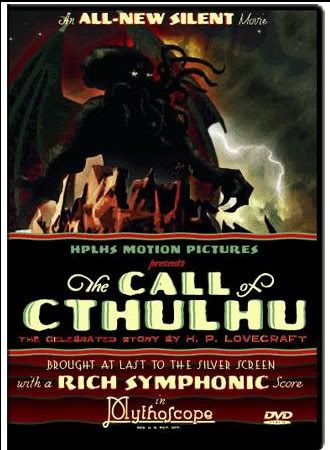
La llamada de Cthulhu
The Call of Cthulhu (2005)
Director: Andrew Leman
Protagonista David Mersault
Argumento:
La película comienza cuando un hombre acude a su psiquiatra y le pide a este que queme unos papeles, éste no le hace caso y al final el protagonista comienza a contarle lo que contienen esos papeles que eran propiedad de su difunto tío, y que a él le están llevando o a la muerte o a la locura. En esos papeles se cuenta la historia de una secta secreta que rinde culto a un monstruo primigenio: Cthulhu.
Para reforzar nuestra tesis, las investigaciones se entroncaran con el testimonio de un marino que tuvo en el océano Pacífico un encuentro con una criatura misteriosa.
Una historia que deleitará tanto a los Lovecrafianos de la logia del tentáculo como a los pulperos en general.
Labels: Cine
Lovecraft y La llamada de Cthulhu
Published by Spyder.H.P. Lovecraft - La llamada de Cthulhu-
Labels: Literatura
Sombrero pulpero en Tahití-
Published Sunday, January 23, 2005 by Spyder.
Real como la vida misma. Puede sucederte si estás disfrutando unos días en la paradisiaca Bora Bora. Y si no, miren la belleza de las fotografías.

Labels: Sombreros
Cocina -Rodaballo con caldo de pulpo seco y crema de zanahoria caramelizada-
Published Saturday, January 22, 2005 by Spyder.Vía Lo mejor de la gastronomía
Todo cuanto define la obra de Isaac Salaberria, especialmente en lo que afecta a los pescados, se ratifica por enésima vez en esta receta, que como siempre se compone de un ingrediente principal al que se aplica una cocción a baja temperatura sumergido en aceite, logrando una naturalidad sápida y táctil sin precedentes. Los lomos del pescado, en entero y espinados, se sazonan con sal gris de Guérande durante cinco minutos. Se cortan, se confitan en aceite de oliva a 60 grados durante 5 minutos. Se mantienen en la grasa y, al momento de servir, se les filtra calor hasta adquirir una temperatura de 40 grados. Además de conseguir un nuevo gusto en el rodaballo, muy diferente del crudo, asado, hervido...se le aporta una nueva textura, consistente, de masticar, un tanto cárnica, y a la vez un corte al cuchillo limpio, y un colorido traslúcido y tornasolado, sin antecedentes, que muestra con claridad las puntas del tenedor al pincharlo. Es el mismo procedimiento que hizo célebre al chicharro, al salmonete, a las anchoas, a las sardinas, superando todos los antecedentes, quizás, porque la citada técnica alcance su cenit con este pez.
Y se recrea en el estilo, en cuanto la construcción es minimalista, interviniendo una crema de zanahoria caramelizada y un caldo de pulpo seco, como siempre servido en chupito, que se ha de beber a pequeños sorbos intercalados con el ingrediente principal y jugando a situarlo antes y después de este y del otro realce.
Ingredientes
Rodaballo salvaje de 3-4 kg
Aceite de oliva arbequina de 0’2º de acidez
Sal de Guérande
Sal Maldon
Perifollo
Elaboración
Filetear el rodaballo. Cubrir los filetes con la sal de Guerande durante 6 minutos. Templar el aceite a 60º e introducir los filetes de rodaballo durante 5 minutos. Reservar.
Para la crema de zanahoria caramelizada
Ingredientes
3 zanahorias
Zumo de 2 naranjas
Aceite de oliva arbequina
Vinagre de Módena
Sal
Elaboración
Trocear las zanahorias y cocer , junto al zumo de naranja, suavemente, hasta caramelizarlos. Triturar las zanahorias hasta que quede un puré fino. Añadir una gota de vinagre de Módena, sal y terminar la crema con dos cucharadas de aceite de oliva.
Para el caldo de pulpo seco
Ingredientes
200 g de pulpo seco
1 cebolla
1 zanahoria
1 puerro
50 cc de vino blanco
Aceite de oliva
Elaboración
Preparar el fondo de verdura . Pochar las mismas y añadir el vino blanco, hasta que reduzca el liquido al 10% del volumen inicial. Introducir el pulpo seco troceado y rehogar. Cubrir con agua. Cocer el conjunto durante 2 horas. Colar y clarificar si fuera necesario. Este caldo se sirve a una temperatura de 45º-55º
Elaboración final
Colocar en el plato la crema de zanahoria. Calentar el filete de rodaballo, en un horno a 120º durante 3 minutos. El filete debe de quedar muy poco hecho , pero caliente en el interior. Terminar con un poco de sal Maldon y unas hojas de perifollo. En un vasito de licor serviremos el caldo de pulpo seco.
Cocinero:Isaac Salaberria
Restaurante: Fagollaga
Localidad:20120 Hernani (Gipuzkoa).
Dirección:Ctra. de Goizueta, 68. Barrio Ereñozu .
943550031. fagollaga@fagollaga.com
Labels: Gastronomía, Recetas
Poema de Rafael Alberti -El ángel del carbón-
Published Friday, January 21, 2005 by Spyder.Labels: Literatura, Poemas
Mordeduras de pulpos -U.S. Navy Diving Manual-
Published Thursday, January 20, 2005 by Spyder.Extreme care should be used when reaching into caves and cervices. Regardless of size, an octopus should be handled carefully with gloves. It is ill advised to spear an octopus, especially the large octopuses found off the coast of the Northwestern United States, due to the risk of being engtangled by the octopus tentacles. If killing an octopus becomes necessary, stabbing it between the eyes is recommended.
First Aid and Treatment.
1.Control local bleeding.
2.Clean and debride the wound and cover with a clean dressing.
3.For suspected blue-ringed octopus bites, a loose constrictive band should not be applied.Apply direct pressure with a pressure bandage and immovilize the extremity in a position that is lower than the heart using splints and elastic bandages.
4.Be prepared to administer mouth-to-mouth resuscitation and cardiopulmonary resuscitation if necessary.
5.Blue-ringed octopus venom is heat stable and acts as a neurotoxin and neuromuscular blocking agent. Venom is not affected by hot water therapy. No antivenin is available.
6.Medical therapy for blue-ringed octopus bites is directed toward management of paralytic, cardiovascular, and respiratory complications. Respiratory arrest is common and intubation with mechanical ventilation may be required. Furation of paralysis is between 4 and 12 hours.Reassure the patient.
7.Administer tetanus prophylaxis as appropriate.
Labels: Comportamiento
Mordeduras de pulpos -Poisenous or Venomous-
Published Wednesday, January 19, 2005 by Spyder.You might be interested in reading the following article by Dr. Caldwell:
Death in a Pretty Package: The Blue-Ringed Octopuses
Thanks to Dr. Roy Caldwell and Colin Dunlop for providing information for this reply.
Labels: Comportamiento
Mordeduras de pulpos -Saliva con neurotoxinas-
Published Tuesday, January 18, 2005 by Spyder. Las glándulas salivares posteriores secretan una sustancia viscosa en la cavidad bucal anterior, la cual es una mezcla de diferentes substancias biológicamente activas.
Las glándulas salivares posteriores secretan una sustancia viscosa en la cavidad bucal anterior, la cual es una mezcla de diferentes substancias biológicamente activas.(Budelmann et al., 1997). La secreción incluye una potente neurotoxina llamada cefalotoxina que provoca la parálisis de las presas retenidas en sus brazos (Ghiretti, 1959). Además, la secreción salivar contiene proteasas (Morishita, 1978), capaces de disolver las uniones musculares del caparazón de los crustáceos y de permitir a los pulpos la ingestión del contenido de éstos, dejando los restos cuticulares completamente limpios cuando son descartados (Best & Wells, 1984; Kasugai, 2001). Recientemente se ha descrito, también, actividad hemolítica en la saliva del pulpo E. cirrhosa, no asociada a enzimas proteolíticos, cuya función podría ser aumentar la permeabilidad de la membrana celular y, de esta manera, favorecer la acción enzimática de los enzimas digestivos (Key et al., 2002). Se ha demostrado la existencia de una elevada actividad proteolítica localizada en las glándulas salivares posteriores de las paralarvas de pulpo (Boucaud-Camou & Roper, 1995), que pueden facilitar la penetración de las toxinas en los tejidos de la presa, pero también pueden desarrollar un papel en la digestión de los tejidos y acelerar la eficiencia y velocidad de la digestión, la cual es más rápida en juveniles de cefalópodos (Boucher-Rodoni et al.,
1987). Se ha discutido sobre la posibilidad de una digestión externa en los octópodos, que parece limitarse a la rotura de las uniones musculares con el caparazón, permitiendo la ingestión del contenido blando de las presas de crustáceos (Mangold & Bidder, 1989). Existen evidencias de este mismo comportamiento alimentario y, por tanto, de digestión externa, en paralarvas de pulpo alimentadas con zoeas de crustáceos, dejando como descarte, tras la alimentación, el exoesqueleto entero y vacío, sin desmembrar los apéndices (Hernández-García et al., 2000).
Labels: Comportamiento
El lenguaje de los cefalópodos
Published Monday, January 17, 2005 by Spyder.Las sepias añaden a su peculiar comunicación visual algunas posturas natatorias y movimientos de sus diez tentáculos. Junto con los pulpos, las sepias y los calamares pertenecen a la clase Cephalopoda, moluscos como los caracoles, babosas y almejas. Los cefalópodos, gigantes mentales del mundo de los moluscos, manipulan objetos con sus tentáculos, nadan a propulsión, comen con picos y ven con ojos tan complejos como los nuestros. En los cefalópodos las conexiones directas entre el cerebro y unos músculos especiales les permiten cambiar de color en una fracción de segundo mediante la relajación o contracción de los cromatóforos.
Estas células de la superficie de la piel, llamadas cromatóforos, están llenas de pigmentos de color rojo, amarillo y negro, pudiendo pasar de la expansión a una fuerte contracción en unas milésimas de segundo. Bajo la capa superficial, células con pigmento blanco e incluso células más profundas con pigmento verde reflejan la luz cuando los cromatóforos contraídos las dejan al descubierto. Para mejorar la comunicación, los cefalópodos también pueden cambiar la textura de su piel acentuando o atenuando las protuberancias de aspecto verrugoso que cubren su librea. Aunque parece ser que los cefalópodos son incapaces de ver los colores, tienen una gran facilidad pare confundirse adecuadamente con su entorno.
Cuando no se están camuflando con el entorno, algunos calamares y sepias pueden crear dramáticos modelos alterando los colores del cuerpo entero o bien sólo de partes del mismo. En algunas especies, se han catalogado 31 variaciones que afectan a todo el cuerpo y se ha calculado un repertorio potencial de 300 diseños en los que se combinan variaciones de color de todo el cuerpo o sólo de algunas partes, de la textura de la piel y de posturas corporales.
Los pulpos son animales solitarios excepto cuando se aparean, y hasta el momento los investigadores han visto poco de lo que llamarían comunicación compleja entre ellos. Pero al igual que los calamares y las sepias, los pulpos muestran cambios de color en función de los estados fisiológicos internos. Los machos de algunas especies de pulpo lucen grandes ventosas, que utilizan en la exhibición de "succión", supuestamente diseñada pare comunicar el sexo al cual pertenecen.
Las hembras de cierta especie desarrollan células luminiscentes, que se disponen alrededor de su pico como un pintalabios de color verde, y que pueden atraer a los machos. La sepia Jane -como las hembras de otras especies- no estará satisfecha con cualquier macho. Ella quiere un Tarzán sano y vigoroso, cuyo esperma contenga genes que incrementen la probabilidad de su descendencia de sobrevivir, madurar y reproducirse de nuevo.
Por este motivo, la sepia hembra busca al macho que presente toda una serie de atributos que ella cree necesarios, por ejemplo, el tamaño, que, naturalmente, es sinónimo de salud, pero además, la sepia y el calamar que nadan con los brazos estirados y con la piel relampagueando aparentemente también les parecen más sanos a las hembras.
El calamar y la sepia constituyen un delicioso manjar -no sólo como sushi, sino también para diferentes depredadores oceánicos -, así que normalmente se difuminan con el entorno adoptando un color críptico, que suele ser moteado. Pero, cuando llega el momento de aparearse, para la sepia macho la oportunidad de pasar sus genes sobrepasa el riesgo de convertirse en una comida. Para anunciar el sexo al cual pertenece, el macho adopta un sorprendente modelo de cebra: estira sus brazos hacia delante, amontonándolos o arqueándolos, formando una cesta de diez ramales. Otras sepias que están por los alrededores captan el mensaje. Los machos devuelven el saludo, pero las hembras no alteran su patrón moteado.
La ausencia del modelo del macho, más que ningún otro rasgo distinguible del cuerpo de la hembra, informa al macho del sexo de la hembra. Si un macho no responde adoptando el modelo de cebra -quizás debido a alguna enfermedad -, otros machos pueden confundirlo con una sepia hembra.
Todos los machos de un grupo se pasean ufanos con su modelo de cebra; sin embargo, la mayoría de las hembras no altera su traje moteado. Pero si una hembra de las proximidades cambia su críptico modelo jaspeado por uno gris más uniforme, está indicando su disponibilidad para aparearse.
Ahora la competencia entre los machos se intensifica, llegando en algunas especies al contacto físico y los mordiscos. Por último, todos los machos, excepto uno -normalmente el más grande -, literalmente se dan la vuelta y se baten en retirada, regresando a su modelo normal, jaspeado unisex -esta conducta es semejante a la postura de sumisión de un perro con la cola entre las piernas.
Después de disuadir a los machos cercanos con su destreza, el macho victorioso abandona su comportamiento agresivo para convertirse en un animal sensible y cariñoso. Se acerca a la hembra y cambia su comunicación visual en táctil, acariciándola delicadamente entre sus ojos y brazos. Al principio, la hembra puede manifestar su alarma adoptando un modelo cromático que indica una profunda turbación. El macho la calma soplándole agua y alejándose suavemente con su mecanismo de propulsión. Sin embargo, el macho lejos de desistir se acerca una y otra vez hasta que la hembra lo acepta, literalmente, con los brazos abiertos.
Si un zafio rival intenta importunar a la pareja, el macho en celo adopta de nuevo su disfraz de cebra, pero esta vez muy intensificado. Si está nadando junto a la hembra, el macho puede incluso mostrar las bandas de su librea únicamente en el lado de su cuerpo que esté frente al intruso. Al mismo tiempo, puede mantener su sexualmente sugestivo uniforme gris en el lado más próximo a la hembra. Por último, la pareja pone en contacto sus brazos y empieza a aparearse. Ambos adquieren, en ese momento, el modelo críptico jaspeado que atrae menos la atención.
Los Calamares
Los calamares, que son más sociales que las sepias, también comunican su disponibilidad pare aparearse con el color de la piel. Se reúnen en grupos de 10 a 30 individuos, pero pronto se deshacen en grupos de cortejo de una hembra y dos o cinco machos. El macho de mayor tamaño intenta alejar a la hembra de los otros pretendientes.
La pareja se entrega a un balanceo precopulatorio, en el que juntos se desplazan suavemente de un lado a otro. Si en ese momento, el macho se acerca demasiado, la hembra puede alejarse veloz como un rayo. El macho la sigue, y este juego de persecución puede continuar durante más de una hora a una velocidad vertiginosa. Posiblemente represente un intento por parte de la hembra de evaluar y certificar la salud del macho.
El calamar macho utiliza el disfraz de cebra de una forma no muy diferente a la de la sepia para ahuyentar a otros machos. También adopta un modelo unilateral de suaves tonos plateados cuyo significado es: "Manténte alejado".
El macho sólo exhibe este modelo en el lado del cuerpo que está más próximo a otros machos; el flanco orientado hacia la hembra lo mantiene sexualmente estimulado. Los calamares no se abrazan para aparearse. En lugar de ello, el macho únicamente intenta acercar al cuerpo de la hembra un pequeño y pegajoso saco de esperma. Mientras alarga este saco, hace que sus cromatóforos palpiten a un ritmo determinado.
Si el saco se engancha, la hembra lo coloca en el receptáculo seminal, completando así el ritual de apareamiento. Los cefalópodos sociales, es decir, los calamares (como Sepioteuthis sepioidea) y las sepias, comunican claramente estados internos -disponibilidad pare la cópula, identificación sexual, etc.
Los equivalentes humanos de estas señales serían ruborizarse, tartamudear y adoptar posturas corporales que manifiesten timidez.
¿Se comunican los cefalópodos algo másque su estado sexual?
Algunos científicos sugieren que sus modelos cromáticos de cuerpo entero actúan como si fueran nombres y verbos, y las pequeñas manchas y dibujos como adjetivos y adverbios. La postura y el movimiento pueden ayudar a establecer el contexto.
"Puede ser que si Sepioteuthis destaca una banda en un lado de su cuerpo, y al mismo tiempo remarca una cejas doradas por encima de los ojos, y levanta los brazos, quizás el significado de la banda haya sido modificado por las cejas doradas y el brazo levantado, de modo que representen algo más complicado o incluso diferente de lo que la banda signifique por sí sola", afirma Jennifer Mather.
Mather es una psicóloga que estudia la conducta de los cefalópodos y enseña en la University of Lethbridge, Lethbridge, Alberta. La hipótesis de Mather, aunque interesante, permanece todavía sin explorar. Para poder investigar con más profundidad la comunicación visual de los cefalópodos, a Mather y otros investigadores les gustaría "hablar" su lengua. Imitando las claves visuales con un modelo coloreado -hasta cierto punto comunicándose con la sepia -, los investigadores han descubierto cambios en su conducta y empiezan a entender su compleja comunicación. "Sospecho que los cefalópodos no van a tener un tipo de lenguaje tan complicado como el nuestro para cuando sepamos si poseen un lenguaje visual -concluye Mather -. Pero sospecho que vamos a encontrar un interesante sistema de comunicación cuando finalmente tengamos el tiempo, la energía y los recursos pare descubrirlo."
Labels: Comportamiento
Mordeduras de pulpos
Published Sunday, January 16, 2005 by Spyder.
An Octopus Bite and its Treatment
By Roland C. Anderson
Labels: Comportamiento
Arte y pulpos -Tony Baloney-
Published Saturday, January 15, 2005 by Spyder.
La página de Tony "Baloney"Juliano
title: Things I Can't Explain to Geico
medium: acrylic on canvas & frame
size: 23.5"x19.5"
price: Sold
an unexplainable car accident. Geico still doesn't believe me!
*Aclaro el humor del artista, Geico es una de las principales aseguradoras de coches de los EEUU
Labels: Artistas
Pulpos y joyas -Donna Mehnert-
Published Friday, January 14, 2005 by Spyder.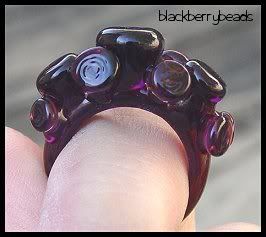
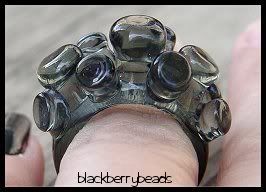
Labels: Joyas
Monstruos fabricados por el hombre
Published Thursday, January 13, 2005 by Spyder.El hombre ha dividido el reino animal en dos categorías: por una parte, los animales «bonitos, buenos y útiles», y, por otra, «los malos, feroces y dañinos». Los animales peor conocidos fueron clasificados a priori en el segundo grupo, incluidos los habitantes de las profundidades marinas, misteriosos durante tanto tiempo. Y, sin embargo, los únicos contactos que el hombre sostuvo con ellos estuvieron marcados por una violencia unilateral; se acercó a ellos para matarlos, exterminarlos o para explotarlos, y casi nunca para conocerlos y protegerlos. El hombre ha poblado el mar con monstruos fabricados por su angustia y por sus miedos, sobre los que descarga la responsabilidad del mal que él mismo engendra y que le sirve para justifica su propia violencia….
Jacques-Yves Cousteau
Labels: Comportamiento
Cousteau juega con los pulpos
Published by Spyder.Escogía a un rehacio alumno. lo sostenía con mano firme y suave y describía varios círculos con él induciéndole a seguirle. El cefalópodo usaba todas las tretas imaginables para escapar. El tímido animalejo solía negarse generalmente a hacer uso de sus ventosas sobre la piel humana. Didi trató de envolver su brazo desnudo con los tentáculos de una de esas criaturas en la posición familiar de los chupadores de sangre. pero no tuvo el menor éxito. El pulpo no quería mantener la presa. Didi oprimió las ventosas contra su brazo y consiguió obtener una breve adhesión muy fácil de suprimir y que dejó marcas momentáneas sobre su piel.
Los pulpos son animales que poseen en alto grado el poder de adaptación. Dumas descubrió esto después de jugar pacientemente con ellos hasta conseguir una cierta correspondencia. Generalmente los pulpos se mostraban más sumisos cuando estaban fatigados. Dumas soltaba a un pulpo, cuando lo veía muy cansado y el animal se alejaba gracias a su sistema de propulsión, pero con los tentáculos colgando inertes.
J. Y. Cousteau y Frédéric Dumas –El mundo silencioso-
Labels: Comportamiento
Pulpo como animal de compañia...
Published Wednesday, January 12, 2005 by Spyder.El Scattergories es un juego de mesa comercial que viene de un juego clásico bastante conocido en el que hay alguien que dice una letra y luego otra persona selecciona una categoría, el fin del juego es intentar decir o escribir en un tiempo determinado el mayor número de palabras posibles relacionadas con la categoría que empiecen por la letra escogida.
El por qué es conocido el juego
Sobre todo se hace alusión a él por ciertos chistes sobre el anuncio en televisión que causó verdadero furor en España. En él aparecen 3 personas: un hombre que sale de una casa enfadado y un matrimonio, la escena se sitúa a la puerta de la casa con el invitado marchándose.
ESCENA 1
PD. Si alguien puede conseguir los anuncios donde se decía aquello de “pues me llevo el Scattergories” o “está bien aceptamos pulpo como animal de compañía”. Por favor indíquenos la manera.
Labels: Comportamiento
Pulpos -Susan Scott- Plants and animals of Hawaii-
Published Tuesday, January 11, 2005 by Spyder.“In Hawai’i, octopuses are called he’e, tako and squid. Two kinds are common; both are active at night.
Octopuses habe lairs or dens. Some build their own homes by pilling up rocks and coral debris, but most move into pre-existing spaces. Glass bottles are favorites of these agile creatures, which can squeeze themselves through tiny holes. But since bottles don’t have back doors, this kind of housing leaves octopuses particularly vulnerable to attack by their most eager predators, moray eels.
An octopus either goes hunting away from its lair or sits in wait jus outside its hole, changing color to match the surrounding area. It leaps on passing fish, shrimp or snails, the injects poison with a bite from strong jaws. The octopus drags the paralyzed animal back to its home to eat in safety. Because of this feeding behavior, octopus dens or “gardens” are often littered cwith discarded bones and shells.
Octopuses have unusual mating habits. The mate has specialized arm for sperm transfer. He inserts the tip of this amr into the female’s mantrle cavity, then transfers seperm down a groove of his arm by muscle contractions. In some species, the end of this sex organ holds a seperm packet that breaks off inside the female and then moves around on its own for a while. The biologists who first discovered this packet thought it was a parasitic worm.
Because most male octopuses are smaller than females, they risk being eatne ir a female isn’t in the courting mood. Demales who are in the mood accept the sperm, then lay eggs in strings from the top of their dens, which they guard with their lives. Females don’t eat during the brooding period and, after their eggs hatch, female octopuses die.
Octopuses are smart. They learn quickly and remember things for a few weeks. In one experiment, researechers gave an octopuses a crab to eat in a square background. If the octopus went for a craba in a rectangle, workers gave the subject a mild shock. The octopus quickly learned tha squares meant food and would attack even empty squares. Although in Hawai’i today people use the word squid to mean octopus, they are two different animals. Ancient Hawaiians recognized squid as a distinct group, calling them muhe’e. Squid aren’t reef animal but swim in the open ocean.
Early Hawaiians ate octopus and used them as medicine for certain illnesses.”
Susan Scott -Plants and Animals of Hawaii-
Via la web de Susan Scott
Marine science writer Susan Scott has written a weekly column, "Ocean Watch," for the Honolulu Star-Bulletin since 1987. You can search the columns by date, title or keyword.
Susan is the author of three books about nature in Hawaii: Oceanwatcher: An Above-Water Guide to Hawaii's Marine Animals; Plants and Animals of Hawaii; and Exploring Hanauma Bay.
Susan and her husband, Craig Thomas, M.D., are co-authors of three highly regarded medical reference books: All Stings Considered: First Aid and Medical Treatment of Hawaii'i's Marine Injuries; Pests of Paradise: First Aid and Medical Treatment of Injuries from Hawai'i's Animals and Poisonous Plants of Paradise: First Aid and Medical Treatment of Injuries from Hawai'i's Plants.
Labels: Características
Roger Caillois y la peligrosidad del pulpo
Published Monday, January 10, 2005 by Spyder.Z. M. Bacq tiene una opinión distinta: "En el fondo de los mares, el pulpo es igual que el tigre en la selva”. Asimismo R. J. Daniel: "Un gran pulpo es el animal mti peligroso con el que pueda topar un buzo". Los polinesios no dudan de que los grandes pulpos ataquen deliberadamente al hombre. Rara vez se arriesgan a caza: solos. Esta prudencia, por lo demás, de ningún modo es prueba de que el pulpo tome la iniciativa. Al compilar las comunicaciones recibidas por Fr. W. Lañe, uno se da cuenta de que los supuestos ataques casi siempre, si no invariablemente, son accidentales o provocados. Ya tuve la oportunidad de señalar que la curiosidad del pulpo lo induce a agarrar cuanto se mueve en su radio de acción. De parte suya, la agresión caracterizada parece excluida...
Roger Caillois –Mitología del pulpo-
Labels: Literatura
Cocina -La gastronomía del pulpo (II)- Consejos
Published Sunday, January 09, 2005 by Spyder.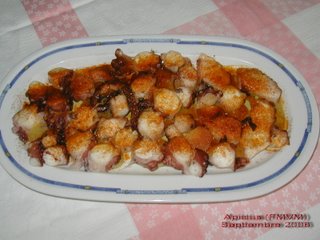
Via la web de Karlos Arguiñano
EL PULPO
Producción y consumo
El pulpo se captura durante todo el año. Se lo comercializa fresco, bien sea cocido o sin cocer, y congelado, en este último taso siempre cocido. También se pueden elaborar conservas a partir de los pulpos de menor tamaño. De los ejemplares de mayor tamaño únicamente se consumen los tentáculos.
En el mercado también se puede adquirir la tinta del pulpo por separado, en pequeñas bolsitas y congelada.
En algunas zonas de la costa sur española se deja secar el pulpo al sol, y después se consume frito. Japón exporta grandes cantidades de pulpos desecados, principalmente a otros países de Extremo Oriente y a la zona del sur de Europa.
Generalmente, el pulpo se comercializa limpio y con la carne ablandada. En caso contrario, hay que limpiarlo y ablandar su carne antes de cocinarlo.
Tradicionalmente, la carne del pulpo se ha ablandado golpeándola contra una superficie dura; sin embargo, actualmente es más frecuente congelarla durante unos tres días, con lo que se consiguen los mismos resultados.
Los pulpos de pequeño tamaño tienen la carne tierna y muy sabrosa, por lo que no es necesario ablandarla.
El pulpo se puede hervir, asar a la parrilla o freír, entre otras preparaciones. También se puede preparar la cabeza rellena con las patas troceadas y estofadas. Combina muy bien con cebolla, ajo, tomate, limón, aceite de oliva, jengibre, vino o salsa de soja. Los pulpos de pequeño tamaño se pueden servir enteros, una vez rebozados y fritos. La tinta del pulpo se aprovecha para elaborar salsas que acompañan a este marisco o a otras preparaciones como la pasta.
A la hora de cocer el pulpo, es muy importante calcular el punto adecuado. Si se hace demasiado, su carne quedará correosa y blanda, aunque si no se cuece lo suficiente resultará demasiado dura. Posteriormente, se ha de dejar reposar durante aproximadamente media hora en el caso de los ejemplares pequeños, y el doble para los de mayor tamaño. Un paso previo a la cocción consiste en escaldar el pulpo antes de cocerlo por completo. Esto recibe el nombre popular de asustar el pulpo.
El pulpo es muy apreciado, interviniendo frecuentemente en platos de la cocina griega e italiana. También es muy solicitado en la cocina oriental, principalmente en Japón y Corea. Sin embargo, en EE UU y Australia es mucho menos popular y únicamente se lo emplea como cebo en la pesca de otras especies.
Se lo suele preparar de muy diferentes formas en Oriente. Los ejemplares más pequeños se suelen condimentar con hierbas aromáticas y especias. Los tentáculos pueden formar parte del sushi, y también se suelen servir partidos en rodajas una vez cocidos acompañando a recetas de arroz.
En la gastronomía gallega el pulpo ocupa un papel muy importante; es muy famosa la forma de preparar el pulpo en esta zona. El pulpo a feira es el pulpo cocido en ollas de cobre, posteriormente troceado en rodajas y servido sobre un plato de madera aliñado con aceite, sal y pimentón. En Málaga se suele preparar el pulpo junto con garbanzos; en la costa catalana son tradicionales los pulpos de pequeño tamaño asados sobre brasas. En el norte de España se elaboran diferentes variedades de sopas y calderetas con pulpo.
Entre los minerales, destaca el aporte de calcio, que es el más alto de todos los mariscos. El calcio es un constituyente de huesos y dientes, interviene en la coagulación sanguínea y es necesario para la transmisión del impulso nervioso.
La vitamina más destacable es la A, que favorece la resistencia a las infecciones y es necesaria para el desarrollo del sistema nervioso. Aporta también una cantidad considerable de vitamina B3 y menores cantidades de vitaminas B, y B2.
Labels: Gastronomía
Poema de Arthur Clement Hilton -Octopus-
Published Saturday, January 08, 2005 by Spyder.Octopus
Strange beauty, eight-limbed and eight-handed,
Whence camest to dazzle our eyes?
With thy bosom bespangled and banded
With the hues of the seas and the skies;
Is thy home European or Asian,
O mystical monster marine?
Part molluscous and partly crustacean,
Betwixt and between.
Wast thou born to the sound of sea trumpets?
Hast thou eaten and drunk to excess
Of the sponges -- thy muffins and crumpets,
Of the seaweed -- thy mustard and cress?
Wast thou nurtured in caverns of coral,
Remote from reproof or restraint?
Art thou innocent, art thou immoral,
Sinburnian or Saint?
Lithe limbs, curling free, as a creeper
That creeps in a desolate place,
To enroll and envelop the sleeper
In a silent and stealthy embrace,
Cruel beak craning forward to bite us,
Our juices to drain and to drink,
Or to whelm us in waves of Cocytus,
Indelible ink!
O breast, that 'twere rapture to writhe on!
O arms 'twere delicious to feel
Clinging close with the crush of the Python,
When she maketh her murderous meal!
In thy eight-fold embraces enfolden,
Let our empty existence escape,
Give us death that is glorious and golden,
Crushed all out of shape!
Ah! thy red lips, lascivious and luscious,
With death in their amorous kiss,
Cling round us, and clasp us, and crush us,
With bitings of agonised bliss;
We are sick with the poison of pleasure,
Dispense us the potion of pain;
Ope thy mouth to its uttermost measure
And bite us again!
By Algernon Charles Sin-Burn
Arthur Clement Hilton (1851-1877)
Labels: Poemas
Cocina -La gastronomía del pulpo-
Published Friday, January 07, 2005 by Spyder. El majestuoso pulpo
El majestuoso pulpoEl pulpo encierra tras de sí una detallada tradición gastronómica, sobre todo en las tierras gallegas, donde este molusco es protagonista de fiestas populares y de recetas milenarias, además de manjar de obligada presencia en cualquier restaurante de comida autóctona. A diferencia del calamar o de la sepia, el pulpo dispone de ocho tentáculos en lugar de diez, por lo que entra dentro de los octópodos.
Los tentáculos del pulpo, de hasta un metro de largo, disponen de dos filas de ventosas pero también hay ejemplares que sólo tienen una, como el pulpo blanco, también llamado cabezudo debido al impresionante tamaño de su cabeza. El pulpo se caracteriza, entre otros aspectos, por su cuerpo blando, su calidad de visión y por la facilidad que tiene para variar la textura y el color de su piel.
El hábitat preferido de este molusco de costumbres nocturnas es el litoral provisto de fondos rocosos. Con la llegada de los meses fríos, el pulpo se aproxima a la costa con objeto de llevar a cabo sus tareas reproductivas pero, al bajar las temperaturas, vuelve a esconderse entre las profundidades cavernosas. Su dieta la componen pequeños peces, crustáceos y otros moluscos. En cuanto a sus propiedades nutritivas, cabe destacar su escaso valor en lo que respecta a calorías y grasas, pero sí es una buena fuente de calcio y de algunas de las más importantes vitaminas.
'Peleando' con el pulpoLa impresionante planta de este cefalópodo ha servido a la literatura de ficción para otorgarle una personalidad cruel pero a la cocina le ha valido de alimento con una increíble gama de posibilidades culinarias. Al estar presente en el mercado todo el año -al igual que el calamar y la sepia-, el pulpo resulta fácil de adquirir, ya sea en su versión fresca o congelada.
Podemos encontrarnos ejemplares desecados y también pulpos que ya han sido sometidos al proceso de cocción, haciéndonos su preparación mucho más sencilla. Y es que ablandar el pulpo es uno de los menesteres más peculiares (y que más adrenalina libera) dentro de la cocina. El trabajo consiste en golpear con fuerza y con firmeza la pieza contra una mesa de material resistente. Hay quien prefiere congelar el pulpo para que la carne se ablande sin necesidad de 'enfadarse' con este rico octópodo. Con los pulpos pequeños, no hace falta ‘pelearse’ porque su carne es perfectamente comestible un vez limpia.
Coger el punto al pulpo en la cocción es una condición indispensable para que, a la hora de hincarle el diente, no lo sintamos ni correoso ni demasiado duro. Uno de los aspectos esenciales es que cuanto más grande sea el ejemplar, mayor será el tiempo que tendremos que dejarlo cocer. Igualmente, tendremos que respetar los tiempos de reposo y el escaldado previo.
De Oriente a Occidente
Las recetas que encabeza este cefalópodo son de lo más variado, y no sólo dentro de la geografía española, sino a lo largo y ancho de todo el mundo. En nuestro país tiene gran fama el pulpo procedente de las costas gallegas, donde su actuación estelar es la receta llamada 'pulpo a feira'. Nuestra vecina Portugal, reboza el pulpo en filetes y lo mezcla con arroz mientras que en Oriente es costumbre acompañarlo de un gran abanico de especias.
Este suculento habitante del mar puede consumirse frito, cocido, a la parrilla, asado, etc. A los guisos con legumbres o con arroz les aporta un toque delicioso y, en la sopa de pescado, encuentra un hueco que seguro que agrada a nuestro paladar. Asimismo, el pulpo relleno, estofado o dentro de un salpicón de marisco se convierte en una vianda incomparable. Por último, no podemos olvidar que su tinta puede servirnos de magnífico aliado.
Labels: Gastronomía
Pulpo -Características-
Published Thursday, January 06, 2005 by Spyder.Morfología externa e interna: el pulpo se caracteriza por tener un cuerpo blando con un cerebro bien desarrollado y ocho brazos, cada uno de los cuales posee dos filas de ventosas, los dos ojos grandes y complejos del pulpo tienen cristalino, lo que les proporciona una visión aguda. Pueden cambiar, de forma, color y textura de su piel. Pasan gran parte de su vida escondiéndose y muchas especies, eligen un agujero natural entre rocas o escombros; Otras prefiere ocultarse en el interior de una almeja vacía, con las valvas unidas aún por un ligamento; el pulpo se asienta sobre una de las valvas y cierra la otra arrastrándola con sus tentáculos.
Alimentación: se alimenta en general de crustáceos y moluscos bivalvos; suele atraer a sus víctimas moviendo rápidamente la punta de un brazo como si fuera un gusano. También puede aproximarse deslizándose y precipitarse sobre el animal, hundiendo su pico en el interior de la envoltura o concha e inyectando un veneno mortal.
Características generales: cuando son atacados, aspiran agua hacia la cavidad del manto y la expelen con una gran fuerza a través de un embudo. Como resultado se produce su fuga propulsada a reacción, normalmente detrás de una nube de tinta. Esta sustancia, que el pulpo expulsa para defenderse, es de color oscuro y la de algunas especies puede tener un efecto paralizante sobre los órganos sensoriales del depredador.
Su cuerpo presenta tres regiones:
Manto: contiene órganos internos, incluidos el tracto digestivo, branquias, saco de la tinta y órganos reproductores.
Extremidades: ocho tentáculos con dos hileras de ventosas equipadas con receptores táctiles y olfativos.
Cabeza.
Aparato reproductor: un macho interesado en aparearse se aproxima a una hembra lo suficiente para que al alargar un brazo modificado, el hectocótilo, pueda tocarla. Este brazo tiene un surco profundo entre las dos filas de ventosas y acaba en un extremo con forma de cuchara. Tras un periodo de galanteo, el macho inserta su brazo bajo el manto de la hembra y los espermatóforos se desplazan hacia abajo por el surco hasta el oviducto de la hembra. Poco después del apareamiento, la hembra comienza la puesta de los huevos en su guarida. Produce, aproximadamente, ciento cincuenta mil en dos semanas y cada uno de ellos está encerrado en una cápsula transparente. La hembra los protege durante 50 días, lanzándoles chorros de agua para airearlos y limpiarlos. Las crías flotan hasta la superficie y se convierten en parte del plancton durante casi un mes, entonces se sumergen e inician su vida normal en el fondo.
Labels: Características
Pulpo -Octopus Vulgaris (II)-
Published Wednesday, January 05, 2005 by Spyder.
Seguramente uno de los artículos más ilustrativos que he leído en relación al pulpo, viene firmado por Miquel Pontes, un informático de profesión que le encanta practicar submarinismo.
En su página web Mare Nostrum podemos encontrar gran cantidad de información sobre el mundo marino.
Pulpo
(Octopus vulgaris)
Miquel Pontes
Este cefalópodo puede llegar a medir 1 metro, incluyendo los brazos, y tener un peso de hasta 10 kg, aunque con frecuencia es mucho más pequeño. En casos excepcionales se afirma que pueden llegar a los 3 metros de largo, con brazos de 2 metros y un peso de 25 kg. pero tal vez solo a grandes profundidades.
Los brazos disponen de dos hileras de ventosas en la parte inferior. La superficie del cuerpo es lisa o con apéndices. El color es muy variable pues el propio pulpo lo cambia, mediante control nervioso, en función del ambiente en que se halle, variando entre rojizo, marrom, amarillento, azulado o gris.
Habita en fondos rocosos, arenosos y en praderas submarinas, desde la superficie hasta los 100 metros de profundidad, en todo el Mediterráneo.
Los pulpos son animales de los fondos, por los que se desplazan con ayuda de sus tentáculos, pero en caso de peligro pueden desplazarse mediante la expulsión de un chorro de agua a través de la cavidad respiratoria, la cual es orientable en diversas direcciones.
Son animales nocturnos que se ocultan durante el día en sus escondrijos. Si no tienen ningún cobijo adecuado cerca, construyen ellos mismos uno a base de piedras que hallen en el fondo, o bien cerrarán la entrada demasiado expuesta de un agujero. Los pulpos pequeños anidan también, durante el periodo de cría, en conchas vacias de moluscos bivalvos.
El pulpo captura cualquier presa que pueda dominar, esencialmente crustáceos, bivalvos y peces, ocasionalmente también carroña. Es un animal inteligente que puede tender una emboscada para capturar desprevenidas a sus presas. También se les observa inspeccionado el fondo de noche y capturando implacables a sus presas dormidas.
Con su poderosa boca, similar a un pico de loro, pueden triturar duros crustáceos e incluso bivalvos, los restos de los cuales a menudo "decoran" la entrada de su guarida, lo que permite localizarlos.
El pulpo se mimetiza con el ambiente, cambiando tanto de forma como de color. Su estado de ánimo tambien influye en los cambios de color, apareciendo ondulaciones azules cuando está excitado, o volviéndose pálido cuando tiene miedo. Si está furioso dominan los colores rojizos.
Los pulpos entablan duras batallas entre machos para conseguir aparearse con una hembra. Una vez conseguido el acoplamiento, mediante la introducción del brazo de cópula en una cavidad del manto de la hembra, ésta pone del orden de 150.000 huevos en cápsulas pequeñas y transparentes con un pedúnculo corto. Estos huevos aparecen reunidos por miles en forma de racimos largos que se sujetan a la parte superior de una cavidad, donde son custodiados por la madre durante dos meses, y oxigenados con agua limpia. Sin este cuidado los huevos se pudrirían y morirían al cabo de poco tiempo.
La madre no se alimenta mientras está cuidando los huevos, y suele morir después de la eclosión de los mismos por debilidad. Los pulpos jóvenes suelen vivir de 1 a 2 meses con la cabeza hacia abajo en el plancton, hasta que comienzan su vida en el fondo. Durante este tiempo es cuando son más vulnerables, por lo que se reduce su número en forma espectacular.
Los pulpos son presas favoritas de morenas y anguilas, por lo que no carecen de enemigos naturales. Su única protección es su capacidad de mimetismo y el poder lanzar nubes de tinta para escapar de sus enemigos, cosa que hacen mediante el mecanismo de propulsión a chorro que hemos comentado, acto seguido buscan un nuevo escondrijo y se mimetizan con él.
Además de los ojos lenticulares, el pulpo dispone de un cerebro muy desarrollado, incluso inteligente. Suelen ser animales muy curiosos, observando de día el ambiente que les rodea desde la seguridad de su escondite. Suelen ser timidos con los buceadores, pues suelen ser martirizados por estos sin otro motivo que el juego. Algunos animales jovenes, sin malas experiencias todavía, pueden dejarse observar durante largo tiempo a corta distancia, mientras ellos observan asimismo a su oponente.
Labels: Características
Pulpo -Octopus Vulgaris-
Published by Spyder.Labels: Características
Pulpos y literatura -Dodie Smith-
Published Tuesday, January 04, 2005 by Spyder.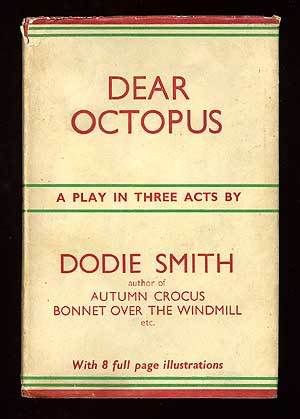
Una comedia sobre la familia, la juventuda, y la vejez. El pulpo en la novela representa los tentáculos de la familia de los que es difícil escapar.
Labels: Literatura
Arte y pulpos -Angela Rosssen-
Published by Spyder.Definición de pulpo
Published Monday, January 03, 2005 by Spyder.Los pulpos constituyen os moluscos más evolucionados. Poseen como características importantes 4 pares de brazos, «tentáculos», prensores y locomotores, uno de los cuales se transforma en los machos en hectocótilo para ayudar a la fecundación de las hembras. La locomoción se realiza por una contracción muscular que expulsa el agua de la cavidad paleal y que por reacción determina un empuje. El digestivo comienza por la boca en el centro de la corona de brazos provista de mandíbulas córneas en forma de pico pudiendo perforar un caparazón de crustáceos, ya que son depredadores, con glándulas secretoras de toxinas que corresponden al segundo par de salivales; el digestivo presenta además en el último tramo del intestino una bolsa de tinta, glándula que produce una secreción oscura que forma una imagen especular del animal, con valor defensivo. Su piel, con cromatóforos de pígmento negro y rojo e iridocitos, le permite fenómenos de cripsis. En general no sobrepasan los 2 m de long., pero se han encontrado pruebas de ejemplares abisales de hasta 8 m. Tienen importancia industrial para la pesca de arrastre y son comestibles.
Gran Enciclopedia Larousse
Labels: Características
